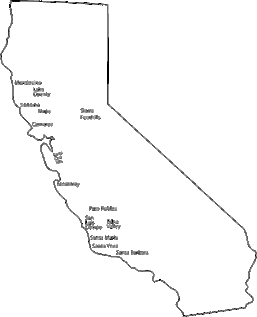

Wine Regions of the World
The best way to learn about the regions around the world is to of course visit them. The second best way is with a good wine atlas. The few regions I have presented here are listed primarily for their importance, and or because I have personally been there. There are many, many more regions around the world then are covered here.
France
The home of many of the world's best known grapes, and best known wines. Because of its importance it has been broken down into a few sections.
Bordeaux
Land of Cabernet Sauvignon, Merlot and the great dessert wines of Sauternes. Here it is the Chateaux the reigns supreme. A 150 year old classification is still in place, determining the hierarchy of the wines.
Burgundy
Pinot Noir for Reds and Chardonnay for whites are the main grapes, while the location of tiny vineyards greatly determines the quality of the wine. Cote de Nuits in the far north is famous for reds, and just to the south Cote de Beaune is renown for its whites. Together they make up the Cote d’Or.
Rhone
Northern Rhone is home to Syrah, while the Southern Rhone host many blends, most based on Grenache. These, earthy, spicy wines have been emulated around the world, but there is no mistaking the real thing.
The Rest of Europe
Italy
From the rich Barolos, to the smooth Brunelos and the well known Chiantis, there is an abundance of red wine styles. Many of the white wines are made from the ubiquitous Trebbiano, but grapes like Muscat and Gavi help break the mode, producing spectacular wines.
Spain
A sea of wine, much of it bulk and sold cheap, but plenty of fine wines are produced here as well. There are enticing reds from the Tempranillo and Grenache grapes, and Cava, the wonderful sparkling wine. There are even long lived and high priced wines to rival any in the world.
Portugal
Too often known only as the home of the magnificent Port wine, but there is plenty more in this country to explore. Port is not the only fortified wine either, the nutty Setubal and long lived Madeira have to be experienced to be believed. Refreshing whites, light reds, this is a country with plenty of variety.
Germany
It is the great Rieslings and sweeter white wines that most think of, but to the locals it is the crisp dry whites that they often cherish the most. Not that all of the wines are similar either, the Pinot Noir grape makes light reds, and the acclaimed Sekt wine is a world class sparkler.
Bulgaria
A hidden gem that few have discovered. Perhaps the world’s largest producer of Cabernet Sauvignon, all of which is easy to approach, and well priced. Crisp, but fruity whites are perfect for lunch and summer sippers..
United States
California
Napa Valley may be the most famous region, but it is very, very far from the only one. Here you will find valleys that face the ocean, terraces draped on mountain slopes, and bay breeze cooled vineyards, all designed to beat the heat. A huge wine growing region with a long and illustrious history.
Pacific Northwest
Two States that are often lumped together due more to their proximity than to similar climates. Pinot Noir and crisp white varietals are produced in Oregon, while rich, long lived Cabernet Sauvignon and Merlot are found in Washington.
NewYork
A State with a growing history older than California, but often overlooked in favor of its western cousins. The climate is tempered in the West by the Finger Lakes, where crisp white wines are produced. While the maritime influences of Long Island are proving ideal for Cabernet and Cab based reds.
Other (travel logs)
Almost every state in the US produces some wine, and the map above shows how many larger commercial wineries were in each state when it was drawn some years ago. The numbers continue to increase. The list below are a number of travel logs from some of these states, most visited in the mid 2000s.
- Iowa
- SW Michigan
- Missouri
- Kansas
- Colorado
- Pennsylvania
The Rest of the New World
Canada
While much of this northern country is too cold for growing grapes, there are a few regions where vines thrive. The temperate western British Columbia and the area around Niagara Falls are the best known of these. Once mostly famed for world class ice wines, there are now a wide range of wine styles being produced, with the industry continuing to grow and define itself.
Chile
Historically this is the land of factory sized wineries producing products better known for their prices than for their quality. While this remains the case for the biggest producers, there are a host of smaller concerns working hard to take advantage of the climate to produce Cabernet and other wines that can compete at all price ranges.
Argentina
A generation ago most of the wines were destined to be shipped by the tanker full to the capital, where people consumed great quantities with regard to quality. Starting in the late 1980s that all changed, as quality became the goal and a major new player on the world stage emerged. Helped by the easy drinkability of Malbec, the wines north and south of Mendoza are now found all over the world.
New Zealand
Pinot Noir and Sauvignon Blanc are the natural choices for the climate here, and for many that is all they expect to find produced on these two Pacific Islands. They would be surprised to find the wide rage of grapes and styles that are not only produced, but thrive here.
Australia
With a long history of producing wine it is no wonder that so many fine wines are produced here. Cabernet Sauvignon and Shiraz (Syrah) are the big players, but there is plenty of whites, sparkling, and fortified wines to go around.

















